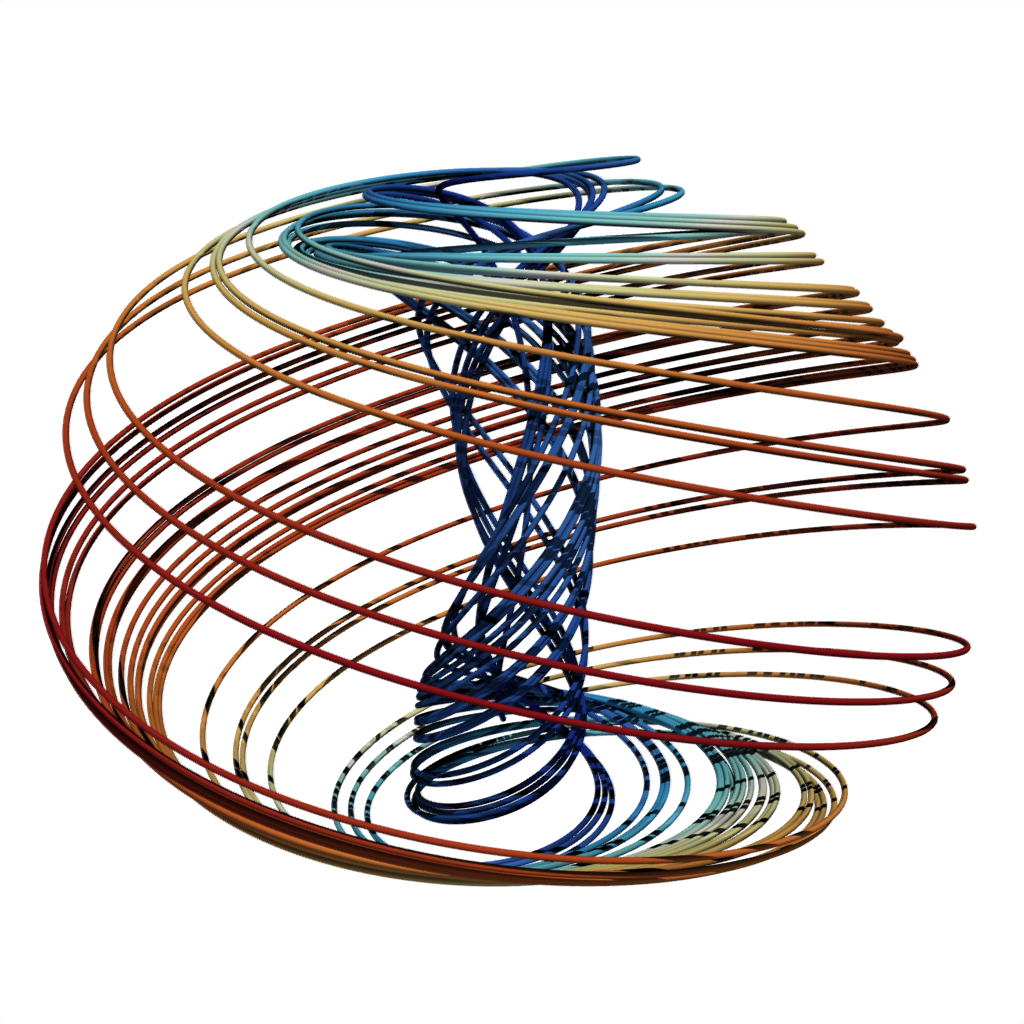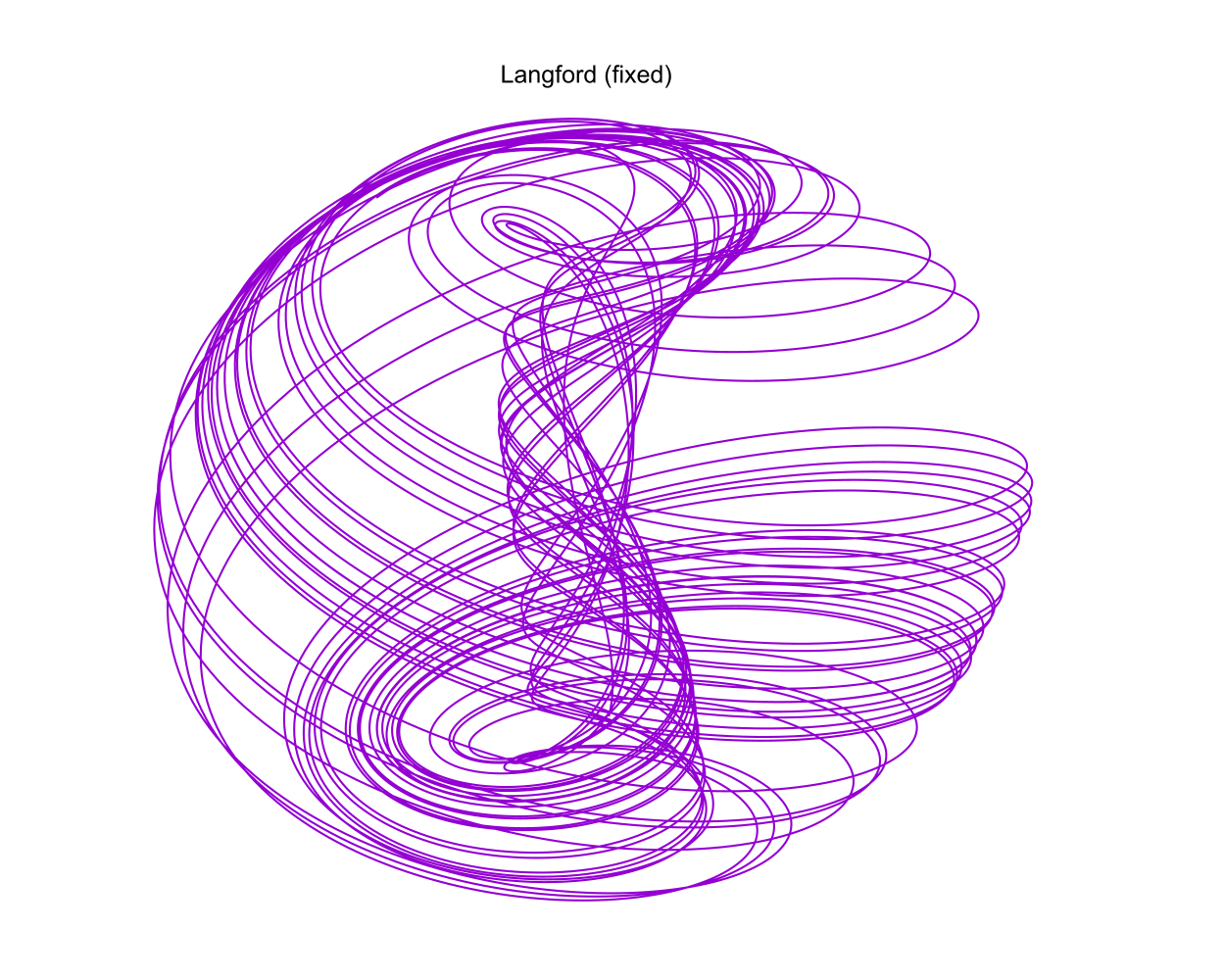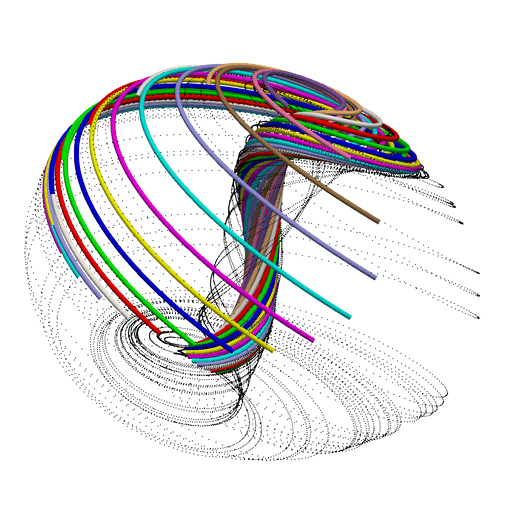The Langford Attractor
A MRKISS Library Example Program
| Author: | Mitch Richling |
| Updated: | 2025-08-18 15:21:31 |
| Generated: | 2025-08-18 15:22:47 |
Copyright © 2025 Mitch Richling. All rights reserved.
Table of Contents
1. Results
The code for this example is found in examples/langford.f90.
Additionally the code may be found at the end of this document in the section Full Code Listing.
The Langford attractor is governed by the following equations:
\[ \begin{align*} \frac{\mathrm{d}x}{\mathrm{d}t} & = (z - \beta) x - \omega y \\ \frac{\mathrm{d}y}{\mathrm{d}t} & = \omega x + (z - \beta) y \\ \frac{\mathrm{d}z}{\mathrm{d}t} & = \lambda + \alpha z - \frac{z^3}{3} - (x^2 + y^2) (1 + \rho z) + \epsilon z x^3 \end{align*} \]
With the following parameter values:
\[ \begin{align*} \alpha & = 0.95 \\ \beta & = 0.70 \\ \lambda & = 0.60 \\ \omega & = 3.50 \\ \rho & = 0.25 \\ \epsilon & = 0.10 \end{align*} \]
And with the following initial conditions:
\[ \begin{align*} x(0) & = 0.1 \\ y(0) & = 0.0 \\ z(0) & = 0.0 \end{align*} \]
We can translate that equation to code like this:
subroutine eq(status, dydt, y, param) integer, intent(out) :: status real(kind=rk), intent(out) :: dydt(:) real(kind=rk), intent(in) :: y(:), param(:) dydt = [(y(3) - param(2)) * y(1) - param(4) * y(2), param(4)*y(1) + (y(3) - param(2))*y(2), param(3) + param(1)*y(3) - (y(3)**3/3) - (y(1)**2+y(2)**2)*(1 + param(5)*y(3)) + param(6)*y(3)*y(1)**3] status = 0 end subroutine eq
We can solve and output the solution to a CSV file like this:
y_iv = [0.1_rk, 0.0_rk, 0.0_rk] call steps_fixed_stab(status, istats, solution, eq, y_iv, param, a, b, c, t_delta_o=t_delta, max_pts_o=15000) call print_solution(status, solution, filename_o="langford_fixed.csv", end_o=istats(1))
If we then load the data into Paraview, we get something like this:

We could also graph it with GNUplot:

Just for fun, let's solve the IVP 20 times with diffrent initial values on a little circle on the central "stalk" structure. We can do that, in parallel, with this little bit of code:
!$OMP PARALLEL DO private(solution, status, istats, filename, i, y_iv) do i=0, num_lines-1 y_iv(1) = cos(i * 2 * pi / num_lines) * 0.15_rk + 0.2_rk y_iv(2) = sin(i * 2 * pi / num_lines) * 0.15_rk y_iv(3) = 0.05_rk call steps_fixed_stab(status, istats, solution, eq, y_iv, param, a, b, c, t_delta_o=t_delta, max_pts_o=350) write (filename, '("langford_",i2.2,".csv")') i call print_solution(status, solution, filename_o=trim(filename), end_o=istats(1), tag_o=i) print *, 'Line Complete: ', i end do !$OMP END PARALLEL DO
We can take the resulting 20 CSV files, load them up into Paraview, and animate the results:

2. Full Code Listing
2.1. Fortran Code
program langford use :: mrkiss_config, only: rk, istats_size use :: mrkiss_solvers_nt, only: steps_fixed_stab use :: mrkiss_utils, only: print_solution use :: mrkiss_erk_kutta_4, only: a, b, c use :: omp_lib implicit none real(kind=rk), parameter :: pi = 4.0_rk * atan(1.0_rk) integer, parameter :: num_lines = 20 integer, parameter :: deq_dim = 3 integer, parameter :: num_points = 100000 real(kind=rk), parameter :: param(6) = [0.95_rk, 0.7_rk, 0.6_rk, 3.5_rk, 0.25_rk, 0.1_rk] real(kind=rk), parameter :: t_delta = 0.01_rk real(kind=rk) :: solution(1+2*deq_dim, num_points), y_iv(deq_dim) integer :: status, istats(istats_size), i character(len=512) :: filename y_iv = [0.1_rk, 0.0_rk, 0.0_rk] call steps_fixed_stab(status, istats, solution, eq, y_iv, param, a, b, c, t_delta_o=t_delta, max_pts_o=15000) call print_solution(status, solution, filename_o="langford_fixed.csv", end_o=istats(1)) !$OMP PARALLEL DO private(solution, status, istats, filename, i, y_iv) do i=0, num_lines-1 y_iv(1) = cos(i * 2 * pi / num_lines) * 0.15_rk + 0.2_rk y_iv(2) = sin(i * 2 * pi / num_lines) * 0.15_rk y_iv(3) = 0.05_rk call steps_fixed_stab(status, istats, solution, eq, y_iv, param, a, b, c, t_delta_o=t_delta, max_pts_o=350) write (filename, '("langford_",i2.2,".csv")') i call print_solution(status, solution, filename_o=trim(filename), end_o=istats(1), tag_o=i) print *, 'Line Complete: ', i end do !$OMP END PARALLEL DO contains subroutine eq(status, dydt, y, param) integer, intent(out) :: status real(kind=rk), intent(out) :: dydt(:) real(kind=rk), intent(in) :: y(:), param(:) dydt = [(y(3) - param(2)) * y(1) - param(4) * y(2), param(4)*y(1) + (y(3) - param(2))*y(2), param(3) + param(1)*y(3) - (y(3)**3/3) - (y(1)**2+y(2)**2)*(1 + param(5)*y(3)) + param(6)*y(3)*y(1)**3] status = 0 end subroutine eq end program langford
2.2. GNUplot Code
The images were produced with GNUplot.
set encoding utf8 set termoption noenhanced set datafile separator ',' set margins 0, 0, 0, 0 set view 50, 40, 1.3, 1.4 set xyplane at 0 unset border unset ytics unset ztics unset xtics set terminal svg set pointsize 0.2 set title "Langford (fixed)" set output "langford_fixed.svg" splot 'langford_fixed.csv' using 3:4:5 with lines title "" set title "Langford (fixed)" set output "langford_multi.svg" splot for [i=1:20] sprintf("langford_%02d.csv", i) using 4:5:6 with lines title ""
The multiple curve graph may be explored interactively with the following code.
set encoding utf8 set termoption noenhanced set datafile separator ',' unset xlabel unset ylabel unset zlabel unset grid unset border unset ytics unset ztics unset xtics set view equal xyz set view 160, 90 set title "Langford" splot for [i=1:20] sprintf("langford_%02d.csv", i) using 4:5:6 with lines title "" pause -1